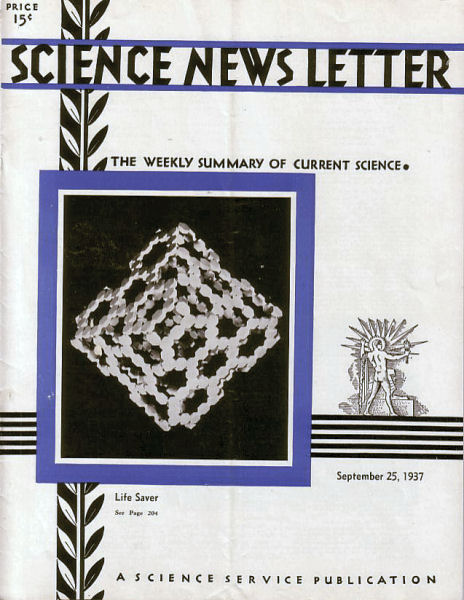From the September 25, 1937, issue

INSULIN MOLECULE HAS COMPLICATED PATTERN
Mathematics, physics, chemistry, and X-ray studies have given Dr. D.M. Wrinch of Oxford University’s Mathematical Institute the model of the complicated insulin molecule, whose atoms are arranged in a crystalline pattern. The model is pictured on the front cover.
NEW FLAMING SUPERNOVA; SECOND WITHIN FORTNIGHT
A second supernova 500,000,000 times as bright as the sun is announced by Dr. Fritz Zwicky of the California Institute of Technology. (See SNL, Sept. 11).
Discovered on a photograph taken at Palomar Mountain on Sept. 10, the new supernova, like that found on August 29, is in a remote extragalactic system, in this instance NGC 1003 in the constellation of Perseus, at a distance of at least 7 million light years.
In spite of its enormous luminosity, the supernova is so distant that it appears as only a faint telescopic star of magnitude 10.5. The date of its outburst is unknown.
Photographs of the spectrum of the new star, taken at the Mount Wilson Observatory of the Carnegie Institution of Washington by Milton Humason on Sept. 12, show the broad bands characteristic of supernovae. Further confirmation of the remarkable character of the star was obtained by Dr. Walter Baade of the Mount Wilson Observatory staff. Dr. Baade, by determining the distance of the spiral system of stars in which it occurs, found that the intrinsic brightness of the supernova, at the lowest estimate, is absolute magnitude minus 16.2, or about 10 times that of all the rest of the stars in the spiral system of which it is a member.
X RAYS KILL LIVING CELLS BY SUFFOCATION; CANCER CLUE
X rays kill living cells by suffocating them, it appears from studies reported by Drs. Hillyer Rudisill Jr. and J. Hampton Hoch of the Medical College of the State of South Carolina at the Fifth International Congress of Radiology, meeting at Chicago.
The findings, in the opinion of the investigators, also show why cancer cells are more susceptible to X rays than normal cells, and may “supply the successful answers to the question, Why cancer?”
Yeast cells were the guinea pigs in the studies. When these cells are X-rayed, the investigators found, certain coenzymes essential for the breathing process of the cells are inactivated by the nascent hydrogen and hydrogen peroxide produced by the X rays. Once the coenzymes are inactivated, they cannot play their part in the complicated mechanism by which cells get their oxygen, and thus deprived of oxygen the cells die. The inactivated coenzymes cannot be reactivated.
Cancer cells, like actively growing cells such as are found in embryonic tissues, have a “greater speed of life” than normal cells, Dr. Rudisill pointed out. It is this, he believes, which accounts for their greater sensitivity to X rays and radium.
Nothing is known of how the cell produces the coenzymes that help it to breathe, Dr. Rudisill observed, and the substances which normally protect the coenzymes from destruction are also unknown. Investigation of these two points, he believes, is likely to answer the question of why cancer develops.







